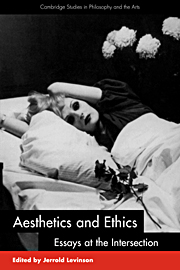Book contents
- Frontmatter
- Contents
- Editor's acknowledgments
- List of contributors
- 1 Introduction: aesthetics and ethics
- 2 Three versions of objectivity: aesthetic, moral, and scientific
- 3 Aesthetic value, moral value, and the ambitions of naturalism
- 4 On consistency in one's personal aesthetics
- 5 Art, narrative, and moral understanding
- 6 Realism of character and the value of fiction
- 7 The ethical criticism of art
- 8 How bad can good art be?
- 9 Beauty and evil: the case of Leni Riefenstahl's Triumph of the Will
- 10 The naked truth
- 11 Aesthetic derogation: hate speech, pornography, and aesthetic contexts
- Bibliography
- Index of names and titles
5 - Art, narrative, and moral understanding
Published online by Cambridge University Press: 22 March 2010
- Frontmatter
- Contents
- Editor's acknowledgments
- List of contributors
- 1 Introduction: aesthetics and ethics
- 2 Three versions of objectivity: aesthetic, moral, and scientific
- 3 Aesthetic value, moral value, and the ambitions of naturalism
- 4 On consistency in one's personal aesthetics
- 5 Art, narrative, and moral understanding
- 6 Realism of character and the value of fiction
- 7 The ethical criticism of art
- 8 How bad can good art be?
- 9 Beauty and evil: the case of Leni Riefenstahl's Triumph of the Will
- 10 The naked truth
- 11 Aesthetic derogation: hate speech, pornography, and aesthetic contexts
- Bibliography
- Index of names and titles
Summary
With much art, we are naturally inclined to speak of it in moral terms. Especially when considering things like novels, short stories, epic poems, plays, and movies, we seem to fall effortlessly into talking about them in terms of ethical significance - in terms of whether or which characters are virtuous or vicious, and about whether the work itself is moral or immoral, and perhaps whether it is sexist or racist. Undoubtedly, poststructuralists will choke on my use of the phrase “naturally inclined,” just because they do not believe that humans are naturally inclined toward anything. But that general premise is as needlessly strong a presupposition as it is patently false. And, furthermore, I hope to show that my talk of natural inclinations is hardly misplaced here, for we are prone to respond to the types of works in question in the language of moral assessment exactly because of the kinds of things they are.
Moreover, we do not merely make moral assessments of artworks as a whole and characters in particular; it is also the case that these moral assessments are variable. That is, we find some artworks to be morally good, while some others are not; some are exemplary, while some others are vicious and perhaps even pernicious; and finally other works may not appear to call for either moral approbation or opprobrium. So, though we very frequently do advance moral assessments of artworks, it is important to stress that we have a gamut of possible evaluative judgments at our disposal: from the morally good to the bad to the ugly, to the morally indifferent and the irrelvant.
- Type
- Chapter
- Information
- Aesthetics and EthicsEssays at the Intersection, pp. 126 - 160Publisher: Cambridge University PressPrint publication year: 1998
- 62
- Cited by

